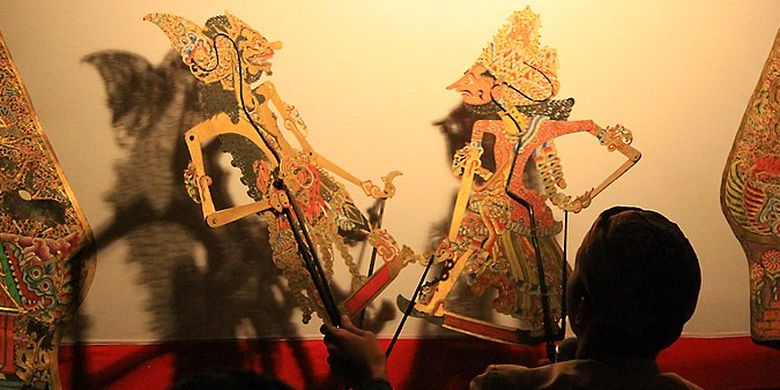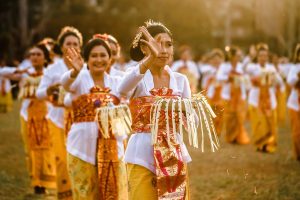Among the many cultural treasures that define Indonesia’s identity, Wayang Kulit stands as one of the most profound and enduring artistic expressions. This intricate shadow puppet theater, carved from leather and brought to life by the master puppeteer known as the dalang, is more than mere entertainment — it is a living philosophy, a spiritual journey, and a reflection of human existence that has evolved over centuries. Wayang Kulit captures the soul of Javanese and Balinese civilization, weaving together myth, morality, religion, and artistry into one mesmerizing performance that continues to inspire audiences across generations.
This article delves deeply into the essence of Wayang Kulit — its history, symbolism, artistry, and continuing relevance — as a vital expression of Indonesia’s intangible cultural heritage.
Origins and Historical Roots of Wayang Kulit

The roots of Wayang Kulit stretch far back in time, tracing an intricate tapestry of cultural exchange and local evolution. The word “wayang” itself means “shadow” or “imagination,” while “kulit” refers to the leather used to craft the puppets.
The origins of Wayang Kulit are believed to date back over a thousand years, emerging in Java around the 9th or 10th century CE, during the era of the Hindu-Buddhist kingdoms such as Medang, Kediri, and Majapahit. Early inscriptions and literary sources — like the Kakawin Ramayana and Kidung Panji — reveal that shadow puppetry was already an established art form, deeply intertwined with religious ritual and royal ceremony.
Also read: 7 Best Things to Do in Nusa Penida for the Ultimate Island Adventure
Wayang Kulit was not just an artistic performance; it was a medium for spiritual and moral teaching. It absorbed influences from India’s epic literature, particularly the Mahabharata and Ramayana, blending them with indigenous animist beliefs and local folklore. Over time, this fusion gave rise to a uniquely Javanese interpretation of Hindu epics — filled with moral complexity, mysticism, and philosophical depth.
When Islam spread across Java in the 15th and 16th centuries, Wayang Kulit adapted once again. Instead of disappearing, it evolved — transforming into a powerful medium for religious and social education. Muslim scholars, notably Sunan Kalijaga, one of the revered Wali Songo (the nine Islamic saints of Java), used Wayang performances to teach Islamic values through symbolism and storytelling. This remarkable adaptability ensured Wayang’s survival across changing cultural and religious landscapes.

The Symbolism Behind the Shadows
At its core, Wayang Kulit is an allegory of life. The performance takes place between a white cotton screen (kelir) and an oil lamp (blencong), which casts shadows of the intricately carved puppets. These shadows symbolize the dual nature of existence — the physical and the spiritual, the visible and the unseen, the temporary and the eternal.
The audience, seated on one side of the screen, perceives only the shadows, while the dalang, seated behind it, manipulates the puppets with astonishing dexterity. This arrangement mirrors the philosophical belief that what humans see in life are mere shadows of a deeper spiritual reality — a concept echoing the Javanese principle of “urip iku mung mampir ngombe” (“life is but a stop for a drink”).
Each component of the performance carries symbolic meaning:
- The oil lamp represents divine light or the cosmic source of truth.
- The white screen symbolizes the boundary between the human and spiritual worlds.
- The dalang acts as a mediator — like a god, philosopher, and storyteller in one — orchestrating the universe of shadows.
- The gamelan orchestra and the rhythmic chanting mirror the cosmic harmony that sustains the universe.
Thus, every Wayang Kulit show becomes a ritual of balance — between light and dark, good and evil, chaos and order — reflecting the Javanese worldview of harmony (rukun) and inner equilibrium (keselarasan).
The Craftsmanship of Wayang Kulit Puppets
Creating a Wayang Kulit puppet is an art form requiring patience, precision, and deep cultural knowledge. The puppets are traditionally made from buffalo hide, which is meticulously cleaned, dried, and carved using tiny chisels and knives. The carver, often referred to as an empu, must possess not only technical skill but also a spiritual connection to the characters he creates.
The design of each puppet is highly symbolic. For example:
- Noble characters like Arjuna or Rama are depicted with slender bodies, delicate features, and downward gazes, symbolizing humility and virtue.
- Villains such as Rahwana or Duryodhana have wide eyes, aggressive postures, and bold colors, signifying arrogance and chaos.
- Clown-servants (punakawan) like Semar, Gareng, Petruk, and Bagong, appear comical and distorted, yet embody wisdom and honesty.
Once carved, the puppets are painted in vivid colors using natural pigments and adorned with gold leaf or foil to enhance their ethereal glow under the lamplight. Each puppet can take weeks or even months to complete.
A full Wayang Kulit troupe may include hundreds of puppets, representing gods, kings, demons, animals, and spirits. The collection reflects not just a narrative inventory but a cosmic hierarchy — from the divine realms to the earthly and the underworld.
The Role of the Dalang: The Mastermind Behind the Shadows
The dalang is the soul of the performance. He is not merely a puppeteer, but also a philosopher, priest, comedian, and conductor — a storyteller who carries the weight of ancient wisdom.
A single Wayang Kulit performance, known as a “wayang purwa”, can last from eight to twelve hours, often performed overnight until dawn. Throughout this marathon, the dalang manipulates dozens of puppets, narrates the story, voices multiple characters, sings in poetic verse, and signals cues to the gamelan orchestra — all while maintaining dramatic tension and rhythm.
The dalang must master:
- Kawruh (knowledge of philosophy, ethics, and spiritual values).
- Catur dalang (speech technique, voice modulation, and character distinction).
- Sabda, bayu, dan cipta (the trinity of word, energy, and imagination).
Traditionally, dalangs were regarded as spiritual figures — intermediaries between humans and the divine. Before performances, they often conducted purification rituals, offerings, and prayers to invoke blessings from ancestral spirits.
A true dalang is not judged by technical skill alone but by his ability to convey moral insight. Through humor, parables, and subtle symbolism, the dalang educates the audience on values like humility, justice, and self-control.
The Storylines: Epic Narratives and Local Wisdom
The two main narrative sources of Wayang Kulit are the Mahabharata and Ramayana — Indian epics that have been adapted to reflect Javanese and Balinese worldviews. Yet, Wayang performances often feature original subplots, known as lakon carangan, which blend elements of mythology, history, and local folklore.
Key types of performances include:
- Wayang Purwa: Classical tales from the Mahabharata and Ramayana cycles.
- Wayang Gedog: Based on the Panji stories, depicting Javanese heroes and royal romances.
- Wayang Wahyu: Introduced by Christian missionaries, using Wayang for biblical storytelling.
- Wayang Parwa: A Balinese variant focusing on Mahabharata stories.
Each performance serves a moral or philosophical purpose. For instance, Arjuna Wiwaha (Arjuna’s Meditation) explores the struggle between worldly desire and spiritual purity, while Dewa Ruci reveals the path of self-realization through the meeting of man and divine essence.
These stories transcend religion — they embody universal values: the search for truth, the balance between duty and desire, and the eternal conflict between good and evil.
The Musical Dimension: Gamelan as the Voice of the Shadows
The gamelan orchestra is an inseparable companion to Wayang Kulit. Its rhythmic patterns and melodic layers create the emotional backbone of the performance, guiding the audience through moods of tension, joy, sorrow, and triumph.
In Java, the gamelan ensemble typically includes saron, bonang, kendhang (drums), gender, and gong instruments, accompanied by sindhen (female vocalists) who sing poetic verses. In Bali, the music is more dynamic and percussive, reflecting the island’s fiery energy.
The dalang commands the gamelan through coded knocks on a wooden chest (kotak), using a small mallet (cempala) held in his foot. This coordination between the dalang and musicians exemplifies the Javanese ideal of gotong royong — harmonious cooperation.
The sound of the gamelan does more than accompany the story; it breathes life into the shadows, enhancing their movement and emotional depth. It transforms the performance into a symphony of sight, sound, and soul.
Wayang Kulit in Balinese Culture
While rooted in Java, Wayang Kulit also flourishes in Bali, where it has taken on distinct stylistic and ritual characteristics. In Balinese tradition, Wayang is not merely an artistic event — it is a sacred ceremony performed during temple festivals, cremations (ngaben), and rites of passage.
The Balinese dalang performs in the context of ritual purification, invoking spiritual protection and harmony. The stories often blend Hindu epics with local myths about gods, demons, and ancestors. The puppets are smaller and more intricately detailed, reflecting Balinese craftsmanship.
A unique Balinese form, Wayang Lemah, is performed without a screen or lamp, symbolizing direct communion with the spiritual realm. It serves as a ritual offering rather than entertainment, reinforcing Wayang’s deep connection to religious life.
Philosophy and Moral Values in Wayang Kulit
Wayang Kulit functions as a mirror of society and a teacher of ethics. Its lessons transcend time, addressing universal human dilemmas — ambition, loyalty, greed, love, and destiny.
Some of the key philosophical teachings embedded in Wayang include:
- Tri Hita Karana (Harmony of Life): The balance between humans, nature, and the divine.
- Karma and Dharma: The moral law of cause and effect, and the duty to uphold righteousness.
- Inner Harmony: The need to balance lahir (outer self) and batin (inner self).
- Rukun and Gotong Royong: The importance of social harmony and collective cooperation.
Through its symbolic language, Wayang becomes a living moral compass, reminding audiences that wisdom comes not from conquest but from understanding one’s place in the cosmic order.
Preservation and Modern Adaptation
In the modern age, Wayang Kulit faces the challenge of surviving amidst digital entertainment and changing lifestyles. Yet, it continues to thrive — thanks to innovation, education, and digital adaptation.
Contemporary dalangs such as Ki Manteb Sudarsono and Ki Enthus Susmono revitalized Wayang by incorporating humor, political satire, and social commentary. Educational institutions and cultural organizations in Java and Bali now teach Wayang to younger generations, ensuring that the craft and philosophy endure.
Technological adaptations, including digital shadow performances, documentaries, and virtual Wayang shows, have brought this ancient art to global audiences. Still, the essence remains the same — a deep spiritual dialogue between light and shadow, humanity and divinity.
Also read: 7 Best Things to Do in Romblon for an Unforgettable Island Escape
Wayang Kulit as UNESCO Intangible Heritage
Recognizing its cultural significance, UNESCO declared Wayang Kulit a Masterpiece of Oral and Intangible Heritage of Humanity in 2003. This honor underscores its role as a living archive of Southeast Asian civilization — a bridge between past and present, tradition and innovation.
Wayang Kulit is not only a representation of Indonesian creativity but also a testament to the power of storytelling as a universal language. It shows how art can transcend borders, uniting people through shared emotion and wisdom.
Conclusion
Wayang Kulit endures because it speaks to something eternal within the human spirit. Beneath its flickering shadows lies a profound message: that life itself is a shadow play — transient yet meaningful, fragile yet divine.
For the Javanese and Balinese, Wayang is not a relic of the past but a living ritual, a continuous dialogue between ancestors and descendants, gods and humans, light and darkness.In every performance, when the dalang raises a puppet and the shadow moves upon the screen, the ancient wisdom of the archipelago breathes once more. Wayang Kulit remains — and will always remain — the beating heart of Indonesia’s cultural soul, a timeless expression of beauty, philosophy, and the eternal search for truth.

Alfath Dewantara is the manager of Jungle Inn Hotel in Bukit Lawang and a leading expert in Bukit Lawang eco-travel. With years of experience in sustainable tourism, he is dedicated to preserving the region’s rich biodiversity while providing authentic jungle experiences for visitors.




